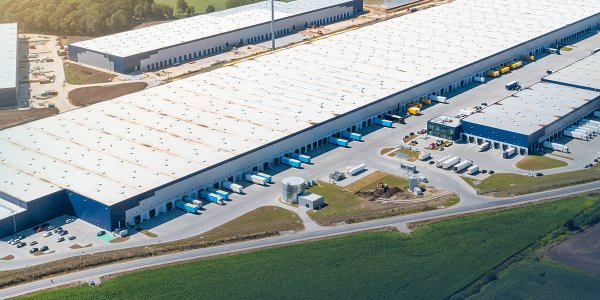In today's dynamic logistics world, flexibility is not a nice extra, but an absolute must. If your company not only wants to grow, but also wants to respond to change in an agile way, it's time to discover the benefits of scalable yard management software (YMS). Rigid solutions that overstretch your resources are a no-go. A flexible YMS helps you to organise your logistics processes efficiently while keeping pace with the requirements of your growing infrastructure.
A digital Yard Management System (YMS) optimises the management of loading points and enables effective planning and control of arrivals and departures to minimise waiting times at the dock and maximise the material flow in your yard. And all in real time. So we're talking about a must-have for your modern, digital and efficient yard logistics and seamless supply chain. But without the necessary flexibility and adaptability of such software, the existing infrastructure quickly reaches its limits during the implementation phase.
Can yard management software adapt flexibly to processes?
Implementing new processes costs resources - both financially and in terms of personnel. Depending on capacities, it can therefore make sense - especially for SMEs - to take a cautious approach to the introduction and gradually introduce all users to the new software and weigh up what is needed to get started. Change management is key. All the better if the YMS software offers sufficient flexibility to adapt the process to the respective individual status quo.
Can I start with a small-scale implementation?
Flexibility enables an introduction that is precisely tailored to your company's needs and your supply chain - whether as a pilot project at one location or as a comprehensive rollout. Thanks to a modular structure, you can set the pace yourself and only include the functions that are really needed.
The more flexible the new YMS software, the more customised the introduction and rollout can be. Companies that want or need to gradually familiarise themselves with new processes and workflows in their yard can start with the basic functions first. This gives everyone involved an initial insight into how it works, and users can be introduced gradually without being overwhelmed. This also means you don't risk any unnecessary cracks in the supply chain. As soon as everyone - your own employees, truck drivers, logistics service providers, etc. - is ready, the software can be gradually expanded to include additional functions.
How quickly can I introduce a YMS?
Does your company already have a higher level of digitalisation or automation? Or do you have enough resources to increase it? Then we advise you to implement the new yard management system right from the start, including all possible or desired functions. This will allow you to exploit all potential immediately and comprehensively optimise your processes. So remember: it's up to you to decide whether you want to take a cautious approach or take the plunge from the 10-metre board.
Can I test yard management software first?
Pilot projects at a specific location offer a valuable opportunity to get to know a new system and optimise operational processes in a focused manner. In a controlled environment, the software can be tested in live operation and valuable insights into its performance can be gained. Such a test phase allows you to make any necessary adjustments before the solution is fully implemented and rolled out to other locations. At the same time, you have the opportunity to obtain feedback from your employees and better assess acceptance.
In this way, you can ensure that the final implementation not only runs smoothly, but also optimally fulfils the specific requirements of your team. Ideally, you should also involve as many departments as possible in the feedback process - from administration to those who manage day-to-day operations at the dock.
After a successful pilot phase, the next logical step is to expand the implemented software solution to other locations.
Regardless of whether you manage a small network or a large logistics chain - the system must adapt seamlessly to your needs and should not have to start the process all over again. This also ensures continuous growth.
At which company size is a yard management system profitable?
The duration of the implementation of a yard management software project does not primarily depend on the size of the company, but on the complexity of the processes to be integrated. Even small yards can require more time-consuming implementations if various systems such as barriers, pre-systems or numerous docks need to be integrated. In addition, there may be requirements for mapping visitor processes or managing truck driver access.
In contrast, for a company that only needs simple functions such as appointment scheduling and truck driver check-in/check-out, project implementation can be much faster. Therefore, it is not the size of the company that influences the duration, but the number and complexity of the required integrations. It is not the size that matters. So it doesn't matter whether 25 or 75 trucks roll across your yard every day.

What is the secret to a smooth rollout?
Templates are useful for covering the requirements of different scenarios. By using predefined templates - depending on the location requirements - tried and tested processes and configurations can then be quickly transferred to other locations. The basic configurations are adopted, while only minor site-specific adjustments are required.
The benefits:
- You save time.
- You take into account previously acquired learnings and site-specific nuances.
- You avoid having to reconfigure every implementation from scratch.
- You ensure transparency at each individual location.
You can use the templates to introduce standardised processes across your entire network of yards, which not only increases efficiency but also guarantees greater process reliability.
Once the yard management software has been established at location 1, it can be seamlessly transferred to other locations, creating a uniform and standardised process landscape. After the initial implementation, the rollout to several locations - whether 10, 20 or 60 - can be realised quickly thanks to the flexible templates. Depending on the complexity, usually in just a few weeks.
This seamless rollout is not only efficient, but also gives companies a clear competitive advantage. While others may have to start from scratch with every implementation, software solutions such as myleo / dsc offer a standardised, fast and customisable approach.
How does an implementation benefit my employees?
Hopefully you've already realised from reading this: we're fans of only implementing software as quickly and intensively as the company can handle it well. And there is a very important reason for this: employee satisfaction.
Especially in times of a shortage of skilled labour, you need every single one of them. Instead of replacing jobs, digital solutions relieve employees of routine tasks. This frees up time for value-adding responsibilities, which in turn increases motivation.
Companies that rely on automation position themselves as attractive employers. This is because they provide their employees with tools to make their work more efficient: a crucial strategy for remaining competitive in a labour market with fewer and fewer skilled workers available.

How does scalable and flexible yard management help to increase efficiency in logistics?
In a rapidly changing logistics world, it is essential to rely on a flexible and scalable software solution that gives you a real-time overview of all movements in a yard and at the docks.
Whether you are a warehouse manager unfamiliar with IT or an IT buyer looking for a new digital solution for your logistics, we are here to support you with our expertise on a seamless supply chain. Above all, we understand the crucial role that flexibility plays in the rollout process and recommend not making any compromises in this area. And it doesn't matter whether it's a new WMS or TMS. If you start with software that is customisable and offers the option of gradually integrating new functions, you will ensure that your company not only works efficiently, but is also ideally equipped for future challenges.
Rely on a solution that grows with your company and take the opportunity to sustainably optimise and manage your processes through automation. Because in modern logistics, it's not just the first step that counts, but also the ability to continuously improve.

